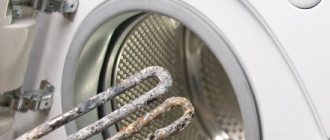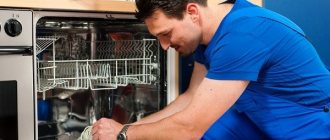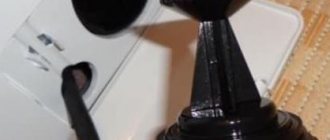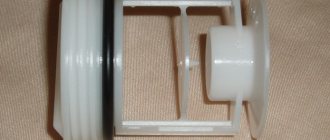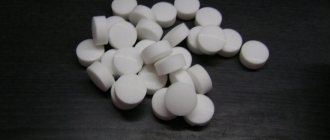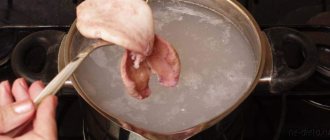Why do you need to carry out maintenance on your washing machine? This allows you to extend the service life and avoid breakdowns and malfunctions of the washing machine. The process consists of three stages:
- daily prevention;
- periodic chemical and physical cleaning;
- inspection of the machine.
Next, we will talk about all the stages and look in detail at how to perform preventative maintenance on your washing machine.
Why does dirt and damp odors appear in the washing machine?
It’s not clear where the dirt comes from, which in theory should go away with running water? It turns out that not all contaminants are removed; some of them remain inside the unit on the working drum. There are several objective and subjective reasons.
Photo 1: Are you bothered by odors and dampness? You don't know how to deal with it? Follow the advice of experts (see below).
- The appearance of limescale on the working surfaces of the unit is caused by the hard water we use. It contains a large amount of iron. It is this that does not completely dissolve in warm water and settles on the walls of the machine in the form of scale.
- In most cases, households wash at t0 water + 400C. This is not enough to split the heats in full. Dirt is retained in the hose and sealing filter and gradually decomposes. Becomes a source of unpleasant odors.
- The chemicals we use: washing powders, various bleaches and other chemicals also accumulate in the tank, becoming overgrown with mold and mildew due to constant humidity.
- Dry clothes can also cause unpleasant odors. After all, we most often accumulate it before washing. In addition, we don’t always take washed items out of the machine, sometimes leaving them overnight.
Photo 2: To avoid the appearance of mold and unpleasant odors, remove the washed laundry from the machine immediately after finishing washing. This may cause unpleasant odors.
- Over time, dirt accumulates on the hose adapter and filter elements in the form of debris coming from washed clothes or threads of paper. Small money forgotten in your pockets can cause the drain hole to become clogged, which over time can lead to premature failure of household appliances.
- Let's summarize what has been said.
If you don't take care of your machine, it will cease to be your assistant. The unit must be maintained and cleaned thoroughly. Read below to learn how to effectively clean your washing machine from dirt. But first, some practical advice from experts.
- Experts advise.
Use the amount of detergent recommended by the manufacturer. Acting on the principle “you can’t spoil porridge with butter,” you can only harm the equipment. Not getting the long-awaited effect from washing dirty clothes. Dose the use of washing powder.
Remove washed laundry immediately after finishing washing. Don't leave it on for a long time. Items that are not removed from the washing machine can cause you additional troubles: they become saturated with an odor that you will have to get rid of by re-washing the laundry.
Regularly carry out general cleaning of equipment intended for washing after 2-3 months of use.
If there are animals in the house, cleaning and cleaning the inside of the tank must be done more often.
By following these simple recommendations, you will extend the life of your washing machine and get rid of unpleasant odors and mold.
Now you can move on to methods for treating the inside of the washing machine, therefore, answer the question of how you can clean the washing machine drum from dirt.
What products can you use to clean washing equipment?
There are several simple and effective ways to get rid of dirt in the drum of your machine/automatic machine:
- using soda;
- acetic acid;
- citric acid;
- chlorine-containing bleaches;
- special means.
Let's look at each of these methods in more detail. Let's take a look at the proposed options for cleaning the interior of the machine/automatic machine.
Where to begin
To get rid of mold in an automatic washing machine, you first need to find all the places where the fungus could have settled. First of all, inspect:
- tray for detergents and the niche in which it is attached;
- rubber seal (cuff) around the machine hatch;
- drain/fill hoses and their filters;
- drum.
All accessible areas must be cleaned with detergents, a brush and a sponge, and then the surfaces must be treated with special compounds to remove mold. If you use store-bought products, be sure to follow the instructions carefully. By the way, today you can find chemicals on sale that are designed specifically for eliminating fungus from a washing machine.
Vinegar removes scale, plaque, rust and mold. Pour a bottle of vinegar (2-3 glasses) into the drum of the machine, spin to distribute the liquid and run a single wash at the highest temperature possible.To combat mold at home you will need:
- gloves and protective mask;
- rags, sponges and brush;
- vinegar, citric acid and soda;
- chlorine-containing products (“Domestos”, “Belizna” or their analogues);
- laundry soap;
- professional means for eliminating mold (in especially advanced cases).
Mold can also damage the internal parts of the machine, for example, the hoses connecting the tray to the drum. However, inspection of such places should only be carried out by a professional technician.
The procedure for cleaning the external parts of the washing machine is as follows:
- disconnect the machine from the power supply and turn off the water;
- Carefully remove the detergent tray and wipe the niche in which it was located. Rinse the tray of powder residues and clean it with a brush, using chlorine-containing liquids or vinegar. Dry the tray;
- Wipe the seal and door of the washing machine with a damp cloth to remove mold, and then treat them with a sponge soaked in a solution of bleach. You can also use thick soda slurry. In severely advanced cases, you should leave the product to act for a day, and then wipe the parts with a damp sponge, having previously moistened it in a solution of laundry soap. If there is little mold, it is enough to apply the selected composition for 2 hours;
- inspect the drum of the machine. If there are visible signs of mold, wipe the drum with a rag soaked in a solution of laundry soap or bleach;
- unscrew the drain filter and wash its mesh with a brush and detergent;
- unscrew the inlet hose (in some cases you need to use a special wrench for this), remove and clean the inlet filter, if it is present in your washing machine model.
Be sure to inspect the drain filter (debris filter), it can also form mold. (When you unscrew the filter cap, a little water will flow out - this is how it should be.)
The initial cleaning is complete. But getting rid of mold in a washing machine is not easy and external treatment will not be enough. Let's move on to the next stage of eliminating fungus - cleaning hard-to-reach places.
Cleaning a machine drum using baking soda
To clean the inside of the appliance, you can use regular baking soda. Mix soda with water, wait until it completely dissolves. Wipe all rubber bands and/or drum with a rag soaked in this solution.
Photo 3. Using soda will help in the fight against unpleasant mud deposits. In addition, the cost of the product will not burden your wallet.
After finishing cleaning, you need to rinse the solution with water and wipe the treated surface dry. The procedure can be performed once a week. It doesn't take long.
Cleaning a top-loading washing machine
This type of appliance is the most difficult to maintain, as it has more problem areas where mold, plaque, and debris accumulate.
Here it is appropriate to use cleaning compounds:
- Run the wash at the highest degrees.
- Pour 2-3 tbsp into water. vinegar.
- After a few minutes, add another 0.5 tbsp. baking soda to start the reaction.
- Stop the device. Let it sit for at least half an hour (maximum an hour) with this solution.
- Wash the powder tray and the outside of the machine with vinegar.
- Continue washing. When the cycle ends, drain the water and see what's inside. Simply wipe off any remaining dirt with a sponge.
So, we have looked at all possible methods of how to clean your assistant and worker - the washing machine from mold and odor inside. In the future, we recommend that you follow the operating instructions, do not close the hatch after washing, and also periodically carry out preventive washing with vinegar.
What you need to know when using chlorine bleach as a cleaning agent
Everyone knows the product “Belizna”, which is sold in stores. This is what you can use to clean the internal parts of the machine/automatic machine. Taking 200 gr. substance (you can use a measuring container) pour it into the snare drum.
Set to a long wash cycle. In this case, the working t0 should be at the level of 600C. Having turned on the unit in the specified mode, wait for the end of the working process and use the rinsing mode. This will allow you to thoroughly rinse the interior and remove any remaining bleach.
At the end of rinsing, you need to wipe the body and rubber components dry. Experts recommend using the product no more than 3 times every 60 days. This is due to the toxicity of bleach.
How to prevent mold
Yes, you can if you follow simple rules:
- Regularly use the high temperature mode (95 ° C), even if you don’t need to wash anything, run the program idle for a maximum time 1-2 times a month.
- Do not use gel-based laundry detergents; very often the gel settles on the internal drains of the machine and creates a breeding ground for a colony of fungi. Use balms, conditioners, and softeners less often.
- Wipe all accessible parts of the machine with a dry cloth after washing, do not close the lid - let all the moisture evaporate.
- After each wash, remove the powder container, rinse with running water, you can additionally wash with bleach, and dry separately. If the dispenser is not removable, do not push it in and clean it from time to time with soda and an old toothbrush.
- Get rid of scale in a timely manner; the fungus feels quite comfortable in its porous structure. Table vinegar is suitable for removing scale; it is also useful for cleaning the shower stall from limescale.
- Remove the laundry from the machine as soon as the wash is finished.
- From time to time, thoroughly clean the hoses and filters from accumulated dirt; organic residues in the filters serve as a source of infection.
A few words about the use of industrial products
You can buy Calgon cleaning product in stores. The product is probably familiar to housewives. It is ideal for cleaning the inside of a washing machine/automatic machine. You don't need a measuring cup and you don't need to search the Internet for recommendations. All the necessary information is on the back of the package.
Photo 4: Cleaner for washing machines
This is not the only option. You can work with “anti-scale”, using it in the fight against white plaque and lime deposits. The product is poured into the drum.
The machine switches to long-term washing mode without items at a water temperature of 600C. It is necessary to monitor the dosage and not exceed the amount recommended by experts.
Do not forget! Excessive use of special products can lead to early failure of rubber seals and components.
Gradients for proper cleaning of washing machines/automatic machines can be purchased at any store and/or household chemicals department.
Rules for using the machine to prevent mold from appearing
Washing machine professionals and manufacturers recommend taking preventive measures:
- Wash clothes once a month at 95 degrees. If there is no such clothing, run the program empty.
- Do not get carried away with helium products. Alternate them with regular powders.
- Do not close the hatch after washing. Wipe the drum and seal with a sponge or dry cloth.
- Check the powder container and rinse aid. You can use a product with chlorine or vinegar, they will help get rid of the problem at the initial stage.
- The washing dispenser can be cleaned with a brush and soda if it is not removable.
- Clean your machine regularly with professional descaling products.
- Do not accumulate dirty laundry in the drum; immediately remove wet, clean laundry.
- Inspect the filters and hose and clean them promptly.
In order for devices to work for a long time and not require regular repairs or replacement of parts, you need to monitor their life. Carry out an inspection, get rid of scale and mold, visible and hidden dirt.
As the fungus grows, it covers the parts of the washing machine with a black layer, leaves marks on washed clothes, and spreads an unpleasant odor throughout the room. The machine can be anything (top-loading, usual), but it is more difficult to get rid of mold; it is better to carry out prevention. Under this condition, mustiness will not appear, and you will not have to think about how to get rid of the fungus.
The article has been verified by the editors
Prevention
Simple prevention methods will help you avoid the formation of persistent plaque:
- It is known that salt particles in hard water crystallize at temperatures above 750. This means that those washing programs in which the water will not heat up above 700 will help reduce the risk of scale formation on the heating element.
- Magnetic water filters will help both washing equipment and its owners. A smart device will make the water less hard, which will benefit the health of apartment residents, while keeping the machine parts clean.
- From time to time it is worth carrying out preventive cleaning. Frequency – every 6 months. For hard water, prevention is recommended at least once every two months.
- Saving on powder is a false economy. Harmful compounds contained in laundry detergents negatively affect the condition of the heating element. It is better to choose a special powder with a softening element.
- The simplest rules will help keep the device in proper condition: do not leave wet laundry in the drum, after washing, wipe the inside with a dry cloth, and periodically ventilate the machine.
Top 7 best ready-made cleansers
The deposits that form on them pose a huge danger to the internal parts of your unit. Companies involved in the production of washing machines recommend using special preparations to clean the drum, heating element and other parts of the machine.
The cleaning ability of these products is based on the presence of a strong acid in their composition. Therefore, they should be used only when a white coating appears.
We list the most effective drugs that help clean the washing machine from dirt and scale.
Magic Power
It fights well against complex types of scale that have accumulated on the drum and heating element due to prolonged use of the unit. Country of origin: Germany. It is considered one of the most effective remedies.
Particularly suitable for use in regions where the water contains various salts, impurities and has a high level of hardness. The drug contains citric acid.
- It is enough to apply once every 6 months.
- High efficiency.
- Comfortable to use.
- The product contains no aggressive ingredients
Top House
Quite an effective product that perfectly removes dirt and scale from parts of the washing machine. One bottle contains 500 ml of product. This makes it possible to carry out up to five cleanings per year.
- The product is quite economical.
- Ease of use.
Antiscale
Available in powder form. Country of origin: Russia. Cleaning is carried out during a “idle” wash, at a temperature of 30 to 40°C. Two packages of this product are poured into the powder compartment.
It will take about 40 minutes to remove the middle layer of scale. The formula is based on diluted vinegar essence.
Pros:
- Suitable for both cleaning washing machines and removing scale from kettles.
- Does not harm rubber elements.
- Doesn't clog the filter.
- There is no pungent odor left after use.
- Easy to use.
Minuses:
- Cannot be used more than once a month.
- The product is very caustic; you only need to work in it with gloves to avoid chemical burns.
Luxus Professional
Country of origin: Russia. The product is available in the form of a gel, which is easy to use - the product is poured into the powder compartment and the “idle” wash is turned on. Consumers note the cost-effectiveness and versatility of the gel - it is also suitable for cleaning the dishwasher and kettle.
Pros:
- The powder is based on plant components.
- The biological substances contained in the product do not pose a danger to people and animals.
- An excellent choice for those who have a lot of electric heating equipment in their home.
- After use, a pleasant lemon scent remains.
Minus:
- If there are heavy scale deposits, the cleaning process must be repeated.
Calgon
Perhaps “Calgon” can be considered one of the most advertised products. Available in powder or gel format. To clean, the product is placed directly into the drum or poured into the powder tray.
Plus:
- Softens water hardness, thereby preventing scale formation.
Minuses:
- Does not remove scale and dirt from washing machine parts.
- High price.
Complex remedy from Dr. Beckman
The German brand produces a product for comprehensive cleaning of dirt, scale and odors, protecting the insides of a washing machine and other home appliances. The cleaner is offered in liquid form, packaged in a 250 ml plastic bottle.
Using the product, contaminants are removed from hard-to-reach places. The cleaning composition contains components to protect metal and rubber parts from damage.
Kaneyo
A chlorine-based liquid cleaning composition from a Japanese brand is effective for removing mold, soap and dirt deposits from the back surface of the drum. The product has a pronounced antibacterial effect and removes musty odors well. Suitable for all drum type washing machines.

